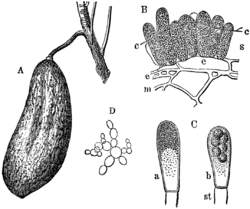Biology:Taphrina
| Taphrina | |
|---|---|

| |
| Taphrina pruni | |
| Scientific classification | |
| Domain: | Eukaryota |
| Kingdom: | Fungi |
| Division: | Ascomycota |
| Class: | Taphrinomycetes |
| Order: | Taphrinales |
| Family: | Taphrinaceae |
| Genus: | Taphrina Fr. (1815) |
| Type species | |
| Taphrina aurea (Pers.) Fr. (1815)
| |
| Synonyms[1] | |
|
Ascomyces Mont. & Desm. | |
Taphrina is a fungal genus within the Ascomycota that causes leaf and catkin curl diseases and witch's brooms of certain flowering plants. One of the more commonly observed species causes peach leaf curl. Taphrina typically grow as yeasts during one phase of their life cycles, then infect plant tissues in which typical hyphae are formed, and ultimately they form a naked layer of asci on the deformed, often brightly pigmented surfaces of their hosts. No discrete fruit body is formed outside of the gall-like or blister-like tissues of the hosts. The asci form a layer lacking paraphyses, and they lack croziers. The ascospores frequently bud into multiple yeast cells within the asci. Phylogenetically, Taphrina is a member of a basal group within the Ascomycota, and type genus for the subphylum Taphrinomycotina, the class Taphrinomycetes, and order Taphrinales.[2][3]
Species
- Taphrina alni (Berk. & Broome) Gjaerum
- Taphrina aurea (Pers.) Fr.
- Taphrina betulina Rostr.
- Taphrina bullata (Berkeley) Tulasne
- Taphrina caerulescens (Desmaz. & Mont.) Tul.
- Taphrina communis (Sadeb.) Giesenh.[4]
- Taphrina coryli
- Taphrina deformans (Berk.) Tul.
- Taphrina entomospora Thaxter
- Taphrina faulliana Mix[5]
- Taphrina filicina Rostr.[5]
- Taphrina hiratsukae Nishida[5]
- Taphrina johansonii Sadebeck
- Taphrina maculans Butler
- Taphrina padi (Jacz.) Mix
- Taphrina piri
- Taphrina polystichi Mix[5]
- Taphrina populina (Fr. ex Fr.) Fr.
- Taphrina potentillae (Farl.) Johans.
- Taphrina pruni Tul.
- Taphrina sadebeckii Johans.
- Taphrina tosquinetii (WestendD.) Magnus
- Taphrina ulmi (Fuckel) Johans.
- Taphrina wiesneri (Rathay) Mix
Footnotes
- ↑ "MycoBank, the fungal website". MycoBank. International Mycological Association. http://www.mycobank.org/MycoTaxo.aspx?Link=T&Rec=5354.
- ↑ Lutzoni; Kauff, F.; Cox, C. J.; McLaughlin, D.; Celio, G.; Dentinger, B.; Padamsee, M.; Hibbett, D. et al. (2004). "Assembling the fungal tree of life: progress, classification, and evolution of subcellular traits". American Journal of Botany 91 (10): 1446–1480. doi:10.3732/ajb.91.10.1446. PMID 21652303.
- ↑ James TY; Kauff, Frank; Schoch, Conrad L.; Matheny, P. Brandon; Hofstetter, Valérie; Cox, Cymon J.; Celio, Gail; Gueidan, Cécile et al. (2006). "Reconstructing the early evolution of Fungi using a six-gene phylogeny". Nature 443 (7113): 818–822. doi:10.1038/nature05110. PMID 17051209. Bibcode: 2006Natur.443..818J.
- ↑ Taphrina communis (Sadeb.) Giesenh., Global Biodiversity Information Facility
- ↑ 5.0 5.1 5.2 5.3 Index of Plant Diseases in the United States (Agricultural Handbook No. 165 ed.). Washington, DC: United States. Agricultural Research Service- Crops Research Division. August 1960. p. 363. https://play.google.com/store/books/details?id=ZYMWAAAAYAAJ&rdid=book-ZYMWAAAAYAAJ&rdot=1. Retrieved 1 December 2021.
References
- Broad leaf plant diseases in Canada (BC)- leaf spot example of Taphrina
- Biology of fungi - microphoto of Taphrina[no|permanent dead link|dead link}}]
- Witches Broom image
- Palaeos "Introduction to the Ascomycota"
- The Oregon Coalition of Interdisciplinary Databases: "Archiascomycetes: Early Diverging Ascomycetes"
- Rodrigues, M. G. (2003). "Molecular systematics of the dimorphic ascomycete genus Taphrina". International Journal of Systematic and Evolutionary Microbiology 53 (2): 607–616. doi:10.1099/ijs.0.02437-0. PMID 12710634.
Wikidata ☰ Q141187 entry
 |

